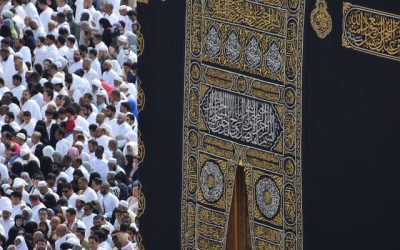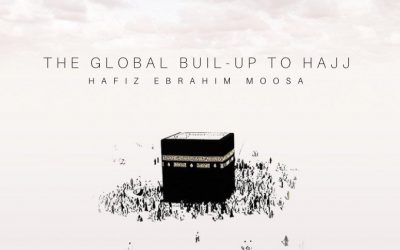Makkah – The Sacred City
—————-
Baytullaah
When Aadam and Hawwaa alayhimas salaam were sent to this earth from
Al Hajarul Aswad
The Hajare Aswad (Black Stone), brought from
The Ka’abah built by Aadam alayhis salaam remained intact upto the time of Nooh alayhis salaam, when it was demolished by the flood and only a mound remained in its place.
Ibraaheem alayhis salaam
Prophet Ibraaheem alayhis salaam was born about 2000 years before ‘Eesaa alayhis salaam in the ninth generation of Nooh alayhis salaam, to guide the pagans to the right path of the Oneness of Allah. At that time the Babylon Empire (modern
Migration
Ibraaheem alayhis salaam preached the worship of One Allah, but his family and the King became his enemies. Seeing the enmity of the people and the King, Ibraaheem alayhis salaam migrated to
Ismaa’eel & Is’haaq alayhimas salaam
Ibraaheem alayhis salaam was childless upto an advanced age. He prayed to Almighty Allah for a child and his request was granted. First Haajirah alayhas salaam gave birth to Ismaa’eel alayhis salaam and after quite a time Saarah alayhas salaam gave birth to Is’haaq alayhis salaam. Ibraaheem alayhis salaam thanked Allah saying: “All praises be to Allah who has given me in my old age Ismaa’eel and Is’haaq. Surely my Lord is the Hearer of Prayer.” (14:39)
Haajirah & Ismaa’eel alayhimas salaam
Ibraaheem alayhis salaam took Haajirah alayhas salaam and Ismaa’eel alayhis salaam to the place where Ka’abah, the House of Allah, is now situated and left them there with a water-skin and some dates on Allah’s command and made the following du’aa: “Our Lord! I have settled some of my posterity in an uncultivable valley near your Sacred House! Our Lord! That they may establish prayer; so incline some hearts of men that they yearn towards them, and provide them with fruits in order that they may be grateful”. (14:37)
When Ibraaheem alayhis salaam was leaving them in the wilderness without any protection or means of sustenance, Haajirah alayhas salaam asked whether he was doing so of his own accord or under instructions from Almighty Allah, to which Ibraaheem alayhis salaam replied that he had been commanded by Allah to do so. Haajirah alayhas salaam said: “Then Allah will not let us go waste.”
Safaa and Marwah
After some time, dates and water finished and the mother and the child grew thirsty. The pangs of this thirst grew gradually and young Ismaa’eel alayhis salaam lay writhing and crying. At this, Haajirah alayhas salaam became extremely worried. She ran hither and thither in search of water. She went to the nearest hill of Safaa to look around for water, then she ran to the other hill Marwah. She ran between Safaa and Marwah seven times and in between the declivity of the hills she ran faster because she could not see Ismaa’eel and feared for his safety. When reaching the top of the hills, she prayed to Almighty Allah for water. This running between the two hills was liked by Allah ta’aalaa so much that it has been made essential on every Hajj pilgrim to do so seven times and it is called Sa’ee.
The Zamzam
Almighty Allah took pity on their sorrowful plight and through His mercy, water gushed forth from the place where the infant Ismaa’eel alayhis salaam lay rubbing his heels on the ground in the intensity of his thirst. Haajirah alayhas salaam was overjoyed and said “Zam, Zam” i.e. stop, stop. She raised an earthen ring round the water to stop its flow. This spring exists to this day and is now called the well of Zamzam. The Holy Prophet sallallahu alayhi wasallam said that if grandmother Haajirah alayhas salaam had not raised a barrier round the water it would have flooded the whole world.
Haajirah and Ismaa’eel alayhimas salaam remained in solitude for five days only. On the sixth day, some people of the Banoo Jurhum tribe happened to come over there and seeing a lonely lady with a child sitting beside a spring, they asked permission to settle there, which Haajirah alayhas salaam gladly granted. They were the first settlers of Makkah. Later on, some people of the Qantoor tribe also came there from
Ismaa’eel’s alayhis salaam Sacrifice
After some years, Ibraaheem alayhis salaam came to see his wife and son. He saw a dream that he was sacrificing his own son Ismaa’eel. The Qur’aan mentions it thus: “And when (his son) was old enough to walk with him, Ibraaheem said: O my dear son! I see in a dream that I am sacrificing you. Consider then what you see. He said: O my father! Do what you are commanded. If Allah wills, you will find me of the patient ones. So when they had both surrendered (to Allah) and he had flung him down on the forehead, We called out to him: O Ibraaheem, you have indeed fulfiled the vision, thus do We reward the doers of good. Surely this is a manifest trial. And We ransomed him with a tremendous sacrifice.” (37:102-107)
Ramee
When Ibraaheem alayhis salaam told his dream to Ismaa’eel alayhis salaam and asked his opinion about it, the latter requested his father to do what he had been commanded to do by Allah ta’aalaa and that he would find him patient and obedient. When father and son were going out to offer sacrifice, the Shaytaan tried to dissuade him from his set purpose three times and each time Ibraaheem alayhis salaam threw seven pebbles at him and he turned into stone. To commemorate this event, pilgrims also throw seven pebbles one by one, on each of the three stones named “Jamaraat or Shaytaan” as part of Hajj rites, in Minaa. This throwing of pebbles is called Ramee.
Animal Sacrifice
After that, Ibraaheem alayhis salaam made Ismaa’eel alayhis salaam lie on the ground and the father and the son, both, blindfolded themselves lest filial love should interfere with the performance of the duty. As Ibraaheem alayhis salaam was putting the knife’s edge on Ismaa’eel’s alayhis salaam throat, Jibra’eel alayhis salaam replaced him by a ram brought from
Maqaame Ibraaheem
Ismaa’eel alayhis salaam grew up and married the daughter of the chief of the Banoo Jurhum tribe who had settled near Zamzam. It was on his third visit to see Ismaa’eel alayhis salaam that Ibraaheem alayhis salaam was commanded by Almighty Allah to build the House of Allah over the sacred mound. Father and son, both began the construction. Ismaa’eel alayhis salaam brought the stones and Ibraaheem alayhis salaam put them in place. When the wall of the Ka’abah had reached shoulder height, Ibraaheem alayhis salaam asked his son to bring a stone. Standing on that stone, Ibraaheem alayhis salaam carried on with the work. The feet of Ibraaheem alayhis salaam left a permanent mark on the stone which is preserved in “Maqaame Ibraaheem” near the Ka’abah.
When the Ka’abah had been completed, Ibraaheem alayhis salaam was commanded by Almighty Allah to give a call to the people to perform Hajj. “And proclaim the pilgrimage among men. They will come to thee on foot and on lean camels from all the deep ravines.” (22:27)
Having given the universal call for Hajj, Ibraaheem alayhis salaam and his dutiful son Ismaa’eel went round the Ka’abah seven times and performed other rites of Hajj as directed by Allah. This sacred building was later repaired once by the Jurhum tribesmen and a second time by an Amalakite King of
Hateem
The Quraysh had left out Hateem from the Ka’abah for lack of funds. During his last years, the Holy Prophet sallallahu alayhi wasallam, had wished to rebuild the Ka’abah on the foundations of Hadhrat Ibraaheem alayhis salaam by including Hateem within the Ka’abah, but he did not live to fulfil his wish. The Hateem therefore, remained outside. The Ka’abah has been rebuilt several times after that but the Hateem has been left out and remains so, till today.
The city of Makkah, built around the Ka’abah is, perhaps, the oldest surviving township in the world. It is more than 5,000 years old. Many memories cling around it. Situated in a barren valley producing nothing, the Makkan complex grew around the life giving natural spring of Zamzam.
In fact, Makkah was known as the city of





0 Comments